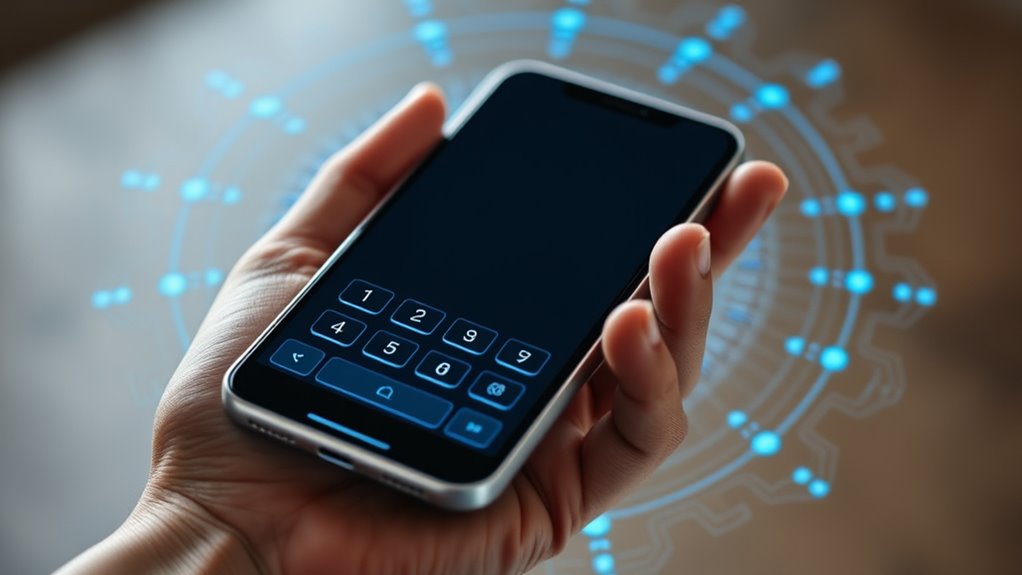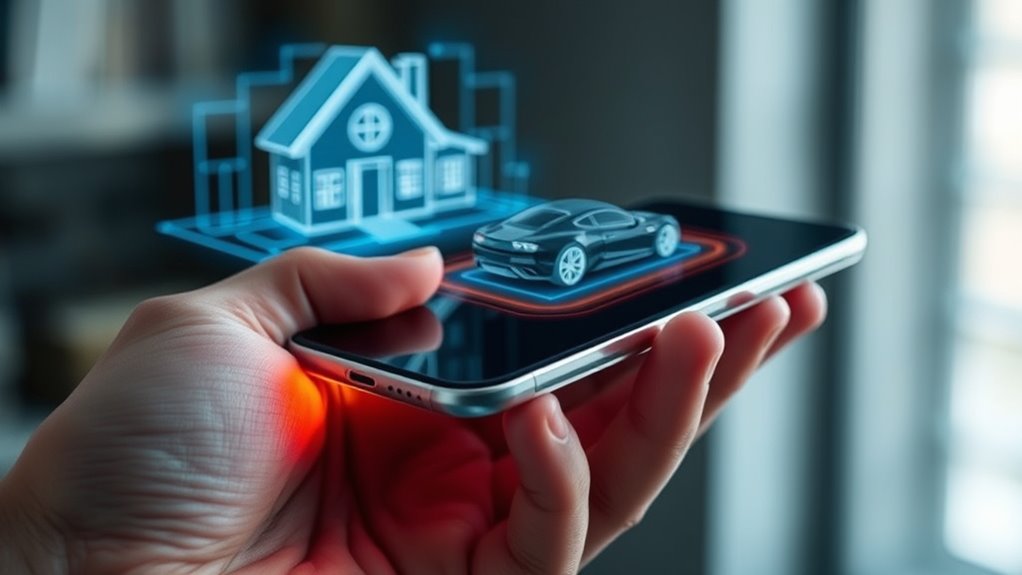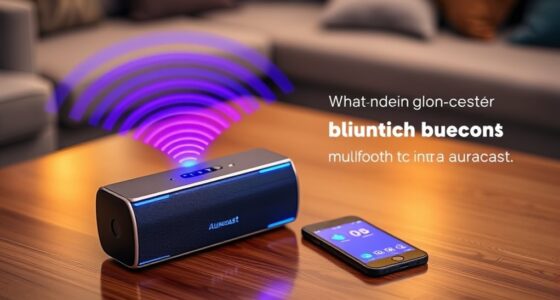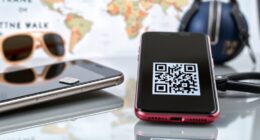UWB on phones uses ultra-wideband signals for pinpoint location tracking and secure digital keys. It lets you find items or devices precisely and unseal your car, home, or office with a tap, all while preventing hacking through advanced security features. UWB also enables seamless device communication and cross-brand compatibility. If you want to discover how this technology is revolutionizing convenience and security, there’s more to uncover ahead.
Key Takeaways
- UWB on phones enables highly accurate location tracking and directional cues for precise device finding.
- It supports secure digital keys for keyless entry, utilizing encrypted, proximity-based authentication.
- UWB technology enhances security by preventing relay and spoofing attacks through precise timing measurements.
- It allows seamless cross-brand device interoperability for location and access services.
- Future uses include advanced AR, smarter smart homes, and more secure vehicle access solutions.
How UWB Enables Precise Location Tracking in Smartphones

UWB enables smartphones to achieve highly precise location tracking by measuring the exact time it takes for radio signals to travel between devices. When you use a UWB-enabled phone, it sends short, ultra-wide pulses to compatible devices or tags. These pulses are timed with nanosecond accuracy, allowing the phone to calculate the distance based on the Time of Flight (ToF). Because UWB transmits very brief signals over a broad frequency spectrum, it achieves centimeter-level accuracy, far surpassing Bluetooth or Wi-Fi. This precise timing allows your phone to determine the exact direction and proximity of other UWB devices in real time. As a result, your device can perform detailed spatial awareness, enabling advanced features like pinpointing objects or steering through complex indoor environments with remarkable accuracy. Understanding UWB technology enhances the ability to utilize precise location data effectively, especially as it relates to lifestyle applications such as digital keys and smart home integration. Additionally, inter-device communication is improved through UWB’s high data transfer capabilities, making interactions more seamless and responsive. Enhanced security features are also supported by UWB’s ability to verify device proximity with high precision.
The Role of UWB in Digital Key and Access Control Systems

By leveraging precise timing measurements, UWB enhances digital key and access control systems with unmatched security and convenience. It enables your phone to act as a secure key, verifying proximity with centimeter-level accuracy. This prevents relay attacks, as the system confirms that the device is physically near, not just within signal range. Unlike signal strength methods, UWB’s ToF-based ranging makes spoofing difficult. Integration into smart locks and car systems allows seamless, hands-free unlocking.
| Feature | Benefit |
|---|---|
| ToF Ranging | Prevents relay attacks |
| Low Power | Enhances security without drain |
| Interoperability | Works across devices |
Security Benefits of UWB Technology on Mobile Devices

The security benefits of UWB technology on mobile devices are significant because its precise timing measurements make it inherently resistant to common spoofing and relay attacks. Unlike signal-strength methods, UWB measures how long radio signals take to travel, providing accurate distance verification. This timing-based approach makes it difficult for hackers to extend or fake device proximity artificially. UWB’s short pulses and low power reduce the risk of eavesdropping or signal interception, enhancing privacy. Additionally, UWB supports encrypted data exchanges and device-to-device authentication, ensuring only authorized devices communicate. This combination of precise location verification and secure communication helps safeguard sensitive transactions, such as digital keys and access controls, offering users stronger protection against unauthorized access and malicious attacks. Enhanced security features further bolster device protection by leveraging the technology’s inherent resistance to interference and tampering, which is rooted in its precise timing measurements. Incorporating secure communication protocols ensures that data exchanged via UWB remains confidential and tamper-proof, strengthening overall security. Furthermore, the integration of UWB in phones allows for secure digital keys, providing a seamless and safer user experience. Additionally, the use of multi-factor authentication can further enhance the security of UWB-enabled access systems.
Interoperability and Data Communication With UWB

How does UWB guarantee seamless communication across diverse devices and brands? UWB achieves this through standardized protocols and interoperable chipsets, allowing devices from different manufacturers to connect effortlessly. It employs common communication standards that guarantee compatibility, regardless of brand. Additionally, UWB’s low interference spectrum enables coexistence with Wi-Fi and Bluetooth without disruptions. The technology supports simultaneous two-way data transfer at speeds up to 27 Mbps, facilitating quick and reliable exchanges. Major manufacturers like Apple, Samsung, and Google incorporate UWB in their flagship devices, guaranteeing broad ecosystem compatibility. This widespread adoption promotes cross-brand interoperability, enabling diverse UWB-enabled devices to work together smoothly. As a result, you can enjoy seamless data communication across your smart home, wearables, and other connected devices. standardized protocols ensure consistent performance and security across different implementations. Furthermore, interoperability standards help maintain a secure environment by reducing potential vulnerabilities during device communication. The ongoing development of universal standards continues to enhance the reliability and security of UWB communications. To maintain optimal performance, regular updates to firmware and software are essential, as they ensure compatibility with evolving industry standards. Additionally, adopting robust security measures is crucial to protect data integrity and privacy during device interactions.
Future Trends and Emerging Uses of UWB in Mobile Technology

As UWB becomes more integrated into smartphones and connected devices, its potential for innovative applications continues to grow. Expect smarter, more secure digital keys that open doors seamlessly and resist spoofing. Future devices will leverage UWB for enhanced augmented reality experiences, enabling precise spatial mapping and object interaction. Location-based services will expand into retail, healthcare, and industrial sectors, offering real-time tracking and automated control. Smart home ecosystems will become more responsive, with devices adjusting based on room presence and user proximity. Vehicle security will advance with ultra-secure digital keys, making car access faster and safer. As UWB standards evolve, expect broader interoperability across brands and peripherals, fueling a wave of innovative, secure, and intuitive mobile experiences. Additionally, the development of standardized protocols will facilitate seamless integration across diverse devices and platforms, unlocking even more possibilities for UWB-enabled technology. Moreover, ongoing research into reliable, safe UWB implementation ensures these advancements are built on a foundation of security and dependability, with predictive analytics playing a crucial role in optimizing system performance and user experience. Recognizing the importance of privacy and security measures, manufacturers are prioritizing user data protection in UWB applications. This ongoing progress reflects a broader trend in connectivity and security that prioritizes both innovation and user trust.
Frequently Asked Questions
How Does UWB Handle Interference From Other Wireless Signals?
UWB handles interference from other wireless signals by operating at a very wide frequency spectrum, typically over 500 MHz, which reduces congestion. Its short pulses, around 2 nanoseconds, enable precise timing measurements and minimize interference. Additionally, UWB transmits at low power levels, preventing signal overlap with Wi-Fi, Bluetooth, or cellular signals. This design guarantees reliable, interference-resistant communication, making UWB highly effective in crowded wireless environments.
Can UWB Be Used to Track Multiple Devices Simultaneously?
Think of UWB like a conductor managing an orchestra; it can coordinate multiple devices at once without missing a beat. Yes, UWB can track multiple devices simultaneously, thanks to its ability to assign unique timing signals and process multiple ToF measurements concurrently. This enables real-time positioning for several objects or people, making UWB perfect for complex environments like smart homes, warehouses, or crowded venues where multi-device tracking is essential.
What Are the Energy Consumption Impacts of UWB on Smartphones?
You’ll find that UWB on smartphones has minimal energy impact due to its low-power design. It transmits very short pulses, which consume less power compared to continuous signals. This efficiency guarantees your device’s battery life isn’t markedly affected, even with frequent use for precise location or digital keys. Overall, UWB’s energy consumption remains manageable, allowing you to benefit from its advanced features without sacrificing your phone’s battery performance.
How Does UWB Integration Affect Smartphone Battery Life?
You might worry that adding UWB drains your phone’s battery, but it actually consumes minimal power thanks to its short pulses and low transmission levels. While UWB runs briefly during precise location tasks or digital key use, it doesn’t stay active constantly. This balance ensures you get advanced features like secure digital keys and pinpoint finding without considerably impacting your battery life, keeping your phone efficient and reliable.
Are There Privacy Concerns With UWB Location Data Sharing?
Yes, there are privacy concerns with UWB location data sharing. You might worry about your precise whereabouts being tracked without your consent or falling into the wrong hands. Since UWB can reveal your exact position indoors, malicious actors could potentially exploit this data for targeted attacks or surveillance. To protect yourself, verify your device’s privacy settings are enabled, and only share UWB location data with trusted apps and contacts.
Conclusion
Just as Icarus soared toward the sun, UWB propels your smartphone into a new domain of precision and security. With its ability to unlock doors, find keys, and communicate seamlessly, UWB transforms your device into a modern-day Daedalus, steering a future of smarter, safer technology. Embrace this innovation, and you’ll harness the power of the gods of connectivity, elevating your mobile experience to mythic heights.









